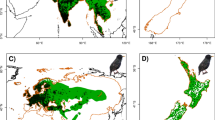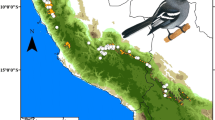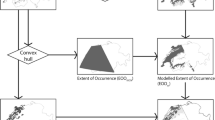Abstract
South India’s Western Ghats are a global biodiversity hotspot and an area of conservation concern with numerous endemic species. There is an urgent need for accurate threat assessments for these species, including the Nilgiri Pipit (Anthus nilghiriensis). The Nilgiri pipit is endemic to the montane grasslands of the Western Ghats, and has experienced recent rapid habitat declines. Here, we characterize the climatic niche of this species using environmental niche modelling, and use these models to estimate its range and threat status. Using the Maxent modelling algorithm and presence data from surveys by expert observers, we find that the Nilgiri Pipit is strongly sensitive to higher temperatures. We project the best-performing models to the last glacial maximum and find evidence that the species had a considerably larger range under that climatic regime. We estimate that the extent of suitable available habitat is no more than 436 km2 even using the most conservative threshold. Based on this result, and the documented decline in and fragmentation of its habitat, we recommend that the species be uplisted to “endangered” on the IUCN Red List, from its current status of “vulnerable”. Finally, we compare these results to models based on identically processed eBird data, and find that eBird data produce larger estimates of suitable habitat: we, therefore, recommend caution in the interpretation of environmental niche models based on eBird data.
Zusammenfassung
Modelle für ökologische Nischen zeigen eine erhöhte Gefährdungsstufe für den Nilgiripieper (Anthus nilghiriensis). Die Westghats in Südindien sind ein globaler Hotspot biologischer Vielfalt und ein Gebiet, das mit seinen zahlreichen endemischen Arten unter besonderem Schutz steht. Für diese Arten, einschließlich des Nilgiripiepers (Anthus nilghiriensis), müssen dringend genaue Analysen des Bedrohungsstatus erstellt werden. Der Nilgiri-Pieper lebt in den bergigen Graslandschaften der Westghats und hat in letzter Zeit einen rapiden Schwund seines Lebensraums erfahren müssen. In dieser Studie wird die klimatische Öko-Nische dieser Art mithilfe von Modellen für ökologische Nischen dargestellt und die Modelle zur Einschätzung ihres Verbreitungsgebiets und Bedrohungsstatus genutzt. Mithilfe des Maxent-Modellierungsalgorithmus und Daten von erfahrenen Beobachtern konnten wir feststellen, dass der Nilgiripieper stark auf höhere Temperaturen reagiert. Wir rechneten die am besten passenden Modelle auf das letzte eiszeitliche Maximum hoch und fanden Hinweise darauf, dass die Art bei jenem Klima ein wesentlich größeres Verbreitungsgebiet hatte. Wir schätzen, dass selbst bei Anwendung des konservativsten Grenzwerts die Größe des geeigneten verfügbaren Lebensraums nicht mehr als 436 km2 beträgt. Auf der Grundlage dieses Ergebnisses, des dokumentierten Rückgangs und der Zerstückelung ihres Lebensraums empfehlen wir, die Art auf der Roten Liste der IUCN von ihrem derzeitigen Status „gefährdet “ auf „vom Aussterben bedroht “ hochzustufen. Schließlich vergleichen wir diese Ergebnisse mit Modellen, die auf identisch aufbereiteten eBird-Daten beruhen und stellen fest, dass eBird-Daten größere Schätzungen für geeignete Lebensräume ergeben: wir raten daher zur Vorsicht bei der Interpretation von ökologischen Nischenmodellen auf der Grundlage von eBird-Daten.





Similar content being viewed by others
Data availability
After careful consideration, we chose not to upload our primary data at the time of submission. The only novel data analyzed here represent locations of a threatened species; in keeping with general practice, we do not wish to make this public. All other data used herein, such as landscape and climate data, are already publicly available from the sources indicated.
References
Aiello-Lammens ME, Boria RA, Radosavljevic A, Vilela B (2015) spThin: an R package for spatial thinning of species occurrence records for use in ecological niche models. Ecography 38:541–545. https://doi.org/10.1111/ecog.01132
Amatulli G, Domisch S, Tuanmu M-N et al (2018) A suite of global, cross-scale topographic variables for environmental and biodiversity modeling. Sci Data 5:180040. https://doi.org/10.1038/sdata.2018.40
Anderson RP, Gonzalez I (2011) Species-specific tuning increases robustness to sampling bias in models of species distributions: an implementation with Maxent. Ecol Model 222:2796–2811. https://doi.org/10.1016/j.ecolmodel.2011.04.011
Arasumani M, Khan D, Das A et al (2018) Not seeing the grass for the trees: Timber plantations and agriculture shrink tropical montane grassland by two-thirds over four decades in the Palani Hills, a Western Ghats Sky Island. PLoS ONE 13:e0190003. https://doi.org/10.1371/journal.pone.0190003
Arasumani M, Khan D, Vishnudas CK et al (2019) Invasion compounds an ecosystem-wide loss to afforestation in the tropical grasslands of the Shola Sky Islands. Biol Conserv 230:141–150. https://doi.org/10.1016/j.biocon.2018.12.019
Araújo MB, Anderson RP, Barbosa AM, et al (2019) Standards for distribution models in biodiversity assessments. Sci Adv 5:eaat4858. https://doi.org/10.1126/sciadv.aat4858
Barbet-Massin M, Jiguet F, Albert CH, Thuiller W (2012) Selecting pseudo-absences for species distribution models: how, where and how many? Methods Ecol Evol 3:327–338. https://doi.org/10.1111/j.2041-210X.2011.00172.x
BirdLife International (2016) IUCN red list of threatened species: Anthus nilghiriensis. In: IUCN Red List Threat. Species. https://www.iucnredlist.org/species/22718582/94586848. Accessed 4 Mar 2021
Bonaccorso E, Rodríguez-Saltos C, Vélez-Márquez A, Muñoz J (2020) Population genetics of the Plumbeous Sierra-finch (Geospizopsis unicolor) across the Ecuadorian paramos: uncovering the footprints of the last ice age. J Ornithol 161:115–123. https://doi.org/10.1007/s10336-019-01700-8
Bond WJ, Parr CL (2010) Beyond the forest edge: Ecology, diversity and conservation of the grassy biomes. Biol Conserv 143:2395–2404. https://doi.org/10.1016/j.biocon.2009.12.012
Boria RA, Olson LE, Goodman SM, Anderson RP (2014) Spatial filtering to reduce sampling bias can improve the performance of ecological niche models. Ecol Model 275:73–77. https://doi.org/10.1016/j.ecolmodel.2013.12.012
Burgess ND, Butynski TM, Cordeiro NJ et al (2007) The biological importance of the Eastern Arc Mountains of Tanzania and Kenya. Biol Conserv 134:209–231. https://doi.org/10.1016/j.biocon.2006.08.015
Burgman MA, Fox JC (2003) Bias in species range estimates from minimum convex polygons: implications for conservation and options for improved planning. In: Animal Conservation Forum. Cambridge University Press, pp 19–28
Buytaert W, Cuesta-Camacho F, Tobón C (2011) Potential impacts of climate change on the environmental services of humid tropical alpine regions. Glob Ecol Biogeogr 20:19–33. https://doi.org/10.1111/j.1466-8238.2010.00585.x
Cobos ME, Peterson AT, Barve N, Osorio-Olvera L (2019) kuenm: an R package for detailed development of ecological niche models using Maxent. PeerJ 7:e6281. https://doi.org/10.7717/peerj.6281
Coxen CL, Frey JK, Carleton SA, Collins DP (2017) Species distribution models for a migratory bird based on citizen science and satellite tracking data. Glob Ecol Conserv 11:298–311. https://doi.org/10.1016/j.gecco.2017.08.001
Das A, Nagendra H, Anand M, Bunyan M (2015) Topographic and bioclimatic determinants of the occurrence of forest and grassland in tropical montane forest-grassland Mosaics of the western Ghats. India PLOS ONE 10:e0130566. https://doi.org/10.1371/journal.pone.0130566
Dixon AP, Faber-Langendoen D, Josse C et al (2014) Distribution mapping of world grassland types. J Biogeogr 41:2003–2019. https://doi.org/10.1111/jbi.12381
eBird (2019) eBird Basic Dataset. Version: EBD_relJul-2019
Elith J, Phillips SJ, Hastie T et al (2011) A statistical explanation of MaxEnt for ecologists. Divers Distrib 17:43–57. https://doi.org/10.1111/j.1472-4642.2010.00725.x
Elsen PR, Tingley MW (2015) Global mountain topography and the fate of montane species under climate change. Nat Clim Change 5:772–776. https://doi.org/10.1038/nclimate2656
Feng X, Park DS, Liang Y et al (2019) Collinearity in ecological niche modeling: confusions and challenges. Ecol Evol 9:10365–10376. https://doi.org/10.1002/ece3.5555
Forero-Medina G, Terborgh J, Socolar SJ, Pimm SL (2011) Elevational ranges of birds on a tropical montane gradient lag behind warming temperatures. PLoS ONE 6:e28535. https://doi.org/10.1371/journal.pone.0028535
Freeman BG, Freeman AMC (2014) Rapid upslope shifts in New Guinean birds illustrate strong distributional responses of tropical montane species to global warming. Proc Natl Acad Sci 111:4490–4494. https://doi.org/10.1073/pnas.1318190111
Freeman BG, Lee-Yaw JA, Sunday JM, Hargreaves AL (2018a) Expanding, shifting and shrinking: the impact of global warming on species’ elevational distributions. Glob Ecol Biogeogr 27:1268–1276. https://doi.org/10.1111/geb.12774
Freeman BG, Scholer MN, Ruiz-Gutierrez V, Fitzpatrick JW (2018b) Climate change causes upslope shifts and mountaintop extirpations in a tropical bird community. Proc Natl Acad Sci 115:11982–11987. https://doi.org/10.1073/pnas.1804224115
Gaworecki M (2017) Overestimated range maps for endemic birds in India’s Western Ghats lead to underestimated threats, study finds. In: Mongabay Environ. News. https://news.mongabay.com/2017/04/overestimated-range-maps-used-for-endemic-birds-in-indias-western-ghats-lead-to-underestimated-threats-study-finds/. Accessed 19 Apr 2021
Grimmett R, Inskipp C, Inskipp T (2016) Birds of the Indian Subcontinent: India, Pakistan, Sri Lanka, Nepal, Bhutan, Bangladesh and the Maldives. Bloomsbury Publishing, London
Guevara L, Gerstner BE, Kass JM, Anderson RP (2018) Toward ecologically realistic predictions of species distributions: a cross-time example from tropical montane cloud forests. Glob Change Biol 24:1511–1522. https://doi.org/10.1111/gcb.13992
Guillera-Arroita G, Lahoz-Monfort JJ, Elith J et al (2015) Is my species distribution model fit for purpose? Matching data and models to applications: Matching distribution models to applications. Glob Ecol Biogeogr 24:276–292. https://doi.org/10.1111/geb.12268
Hoffmann M, Hilton-Taylor C, Angulo A et al (2010) The Impact of Conservation on the Status of the World’s Vertebrates. Science 330:1503–1509. https://doi.org/10.1126/science.1194442
Inman R, Franklin J, Esque T, Nussear K (2021) Comparing sample bias correction methods for species distribution modeling using virtual species. Ecosphere 12:e03422. https://doi.org/10.1002/ecs2.3422
IUCN (2012) IUCN Red List categories and criteria, version 3.1, 2nd edn. IUCN
Jetz W, Sekercioglu CH, Watson JE (2008) Ecological correlates and conservation implications of overestimating species geographic ranges. Conserv Biol 22:110–119. https://doi.org/10.1111/j.1523-1739.2007.00847.x
Joshi AA, Sankaran M, Ratnam J (2018) ‘Foresting’ the grassland: Historical management legacies in forest-grassland mosaics in southern India, and lessons for the conservation of tropical grassy biomes. Biol Conserv 224:144–152. https://doi.org/10.1016/j.biocon.2018.05.029
Joshi AA, Ratnam J, Sankaran M (2020) Frost maintains forests and grasslands as alternate states in a montane tropical forest–grassland mosaic; but alien tree invasion and warming can disrupt this balance. J Ecol 108:122–132. https://doi.org/10.1111/1365-2745.13239
Karger DN, Conrad O, Böhner J et al (2017) Climatologies at high resolution for the earth’s land surface areas. Sci Data 4:170122. https://doi.org/10.1038/sdata.2017.122
Karger DN, Nobis MP, Normand S et al (2021) CHELSA-TraCE21k v1. 0. Downscaled transient temperature and precipitation data since the last glacial maximum. Clim past Discuss 19:439–456
Karger DN, Conrad O, Böhner J, et al (2018) Data from: climatologies at high resolution for the earth’s land surface areas. EnviDat. https://doi.org/10.16904/envidat.228.v2.1
Kearney M, Porter W (2009) Mechanistic niche modelling: combining physiological and spatial data to predict species’ ranges. Ecol Lett 12:334–350. https://doi.org/10.1111/j.1461-0248.2008.01277.x
Kessler M (2000) Observations on a human-induced fire event at a humid timberline in the Bolivian Andes. Ecotropica 6:89–93
Lee CKF, Keith DA, Nicholson E, Murray NJ (2019) Redlistr: tools for the IUCN Red Lists of ecosystems and threatened species in R. Ecography 42:1050–1055. https://doi.org/10.1111/ecog.04143
Lele A, Arasumani M, Vishnudas CK et al (2020) Elevation and landscape change drive the distribution of a montane, endemic grassland bird. Ecol Evol 10:7755–7767. https://doi.org/10.1002/ece3.6500
Liu C, Berry PM, Dawson TP, Pearson RG (2005) Selecting thresholds of occurrence in the prediction of species distributions. Ecography 28:385–393. https://doi.org/10.1111/j.0906-7590.2005.03957.x
Liu C, Newell G, White M (2016) On the selection of thresholds for predicting species occurrence with presence-only data. Ecol Evol 6:337–348. https://doi.org/10.1002/ece3.1878
Luoto M, Virkkala R, Heikkinen RK (2007) The role of land cover in bioclimatic models depends on spatial resolution. Glob Ecol Biogeogr 16:34–42. https://doi.org/10.1111/j.1466-8238.2006.00262.x
Mace GM, Collar NJ, Gaston KJ et al (2008) Quantification of extinction risk: IUCN’s system for classifying threatened species. Conserv Biol 22:1424–1442. https://doi.org/10.1111/j.1523-1739.2008.01044.x
Merow C, Smith MJ, Silander JA (2013) A practical guide to MaxEnt for modeling species’ distributions: what it does, and why inputs and settings matter. Ecography 36:1058–1069. https://doi.org/10.1111/j.1600-0587.2013.07872.x
Myers N, Mittermeier RA, Mittermeier CG et al (2000) Biodiversity hotspots for conservation priorities. Nature 403:853. https://doi.org/10.1038/35002501
Nagendra H, Utkarsh G (2003) Landscape ecological planning through a multi-scale characterization of pattern: studies in the Western Ghats, South India. Environ Monit Assess 87:215–233. https://doi.org/10.1023/A:1024878925038
Ocampo-Peñuela N, Jenkins CN, Vijay V et al (2016) Incorporating explicit geospatial data shows more species at risk of extinction than the current Red List. Sci Adv 2:e1601367. https://doi.org/10.1126/sciadv.1601367
Owens HL, Campbell LP, Dornak LL et al (2013) Constraints on interpretation of ecological niche models by limited environmental ranges on calibration areas. Ecol Model 263:10–18. https://doi.org/10.1016/j.ecolmodel.2013.04.011
Pacifici M, Visconti P, Butchart SH et al (2017) Species’ traits influenced their response to recent climate change. Nat Clim Change 7:205–208. https://doi.org/10.1038/nclimate3223
Parmesan C (2006) Ecological and evolutionary responses to recent climate change. Annu Rev Ecol Evol Syst 37:637–669. https://doi.org/10.1146/annurev.ecolsys.37.091305.110100
Parmesan C, Yohe G (2003) A globally coherent fingerprint of climate change impacts across natural systems. Nature 421:37–42. https://doi.org/10.1038/nature01286
Perktaş U, Peterson AT, Dyer D (2017) Integrating morphology, phylogeography, and ecological niche modeling to explore population differentiation in North African Common Chaffinches. J Ornithol 158:1–13. https://doi.org/10.1007/s10336-016-1361-3
Peterson AT, Sánchez-Cordero V, Soberón J et al (2001) Effects of global climate change on geographic distributions of Mexican Cracidae. Ecol Model 144:21–30. https://doi.org/10.1016/S0304-3800(01)00345-3
Peterson AT, Papeş M, Soberón J (2008) Rethinking receiver operating characteristic analysis applications in ecological niche modeling. Ecol Model 213:63–72. https://doi.org/10.1016/j.ecolmodel.2007.11.008
Philips SJ, Dudík M, Schapire RE (2019) Maxent software for modeling species niches and distributions. http://biodiversityinformatics.amnh.org/open_source/maxent/. Accessed 09 Dec, 2019
Phillips SJ, Anderson RP, Schapire RE (2006) Maximum entropy modeling of species geographic distributions. Ecol Model 190:231–259. https://doi.org/10.1016/j.ecolmodel.2005.03.026
Phillips SJ, Dudík M, Elith J et al (2009) Sample selection bias and presence-only distribution models: implications for background and pseudo-absence data. Ecol Appl 19:181–197. https://doi.org/10.1890/07-2153.1
Qiao H, Feng X, Escobar LE et al (2019) An evaluation of transferability of ecological niche models. Ecography 42:521–534. https://doi.org/10.1111/ecog.03986
R Core Team (2020) R: a language and environment for statistical computing. https://www.r-project.org/ Accessed 09 Dec, 2019
Ramesh V, Gopalakrishna T, Barve S, Melnick DJ (2017) IUCN greatly underestimates threat levels of endemic birds in the Western Ghats. Biol Conserv 210:205–221. https://doi.org/10.1016/j.biocon.2017.03.019
Ricketts TH, Dinerstein E, Boucher T et al (2005) Pinpointing and preventing imminent extinctions. Proc Natl Acad Sci 102:18497–18501. https://doi.org/10.1073/pnas.0509060102
Robin VV, Vishnudas CK, Gupta P, Ramakrishnan U (2015) Deep and wide valleys drive nested phylogeographic patterns across a montane bird community. Proc R Soc B 282:20150861. https://doi.org/10.1098/rspb.2015.0861
Robin VV, Vishnudas CK, Ramakrishnan U (2014) Reassessment of the distribution and threat status of the Western Ghats endemic bird, Nilgiri Pipit Anthus nilghiriensis. Curr Sci 104: 622–630. https://www.jstor.org/stable/24103534
Sankaran M (2009) Diversity patterns in savanna grassland communities: implications for conservation strategies in a biodiversity hotspot. Biodivers Conserv 18:1099–1115. https://doi.org/10.1007/s10531-008-9519-9
SoIB (2023) Nilgiri Pipit. In: State India's Birds. https://stateofindiasbirds.in/species/nilpip1/. Accessed 11 Sept 2023
Stuhldreher G, Fartmann T (2018) Threatened grassland butterflies as indicators of microclimatic niches along an elevational gradient—implications for conservation in times of climate change. Ecol Indic 94:83–98. https://doi.org/10.1016/j.ecolind.2018.06.043
Syfert MM, Smith MJ, Coomes DA (2013) The effects of sampling bias and model complexity on the predictive performance of MaxEnt species distribution models. PLoS ONE 8:e55158. https://doi.org/10.1371/journal.pone.0055158
Syfert MM, Joppa L, Smith MJ et al (2014) Using species distribution models to inform IUCN Red List assessments. Biol Conserv 177:174–184. https://doi.org/10.1016/j.biocon.2014.06.012
Thomas S, Palmer M (2007) The montane grasslands of the Western Ghats, India: community ecology and conservation. Community Ecol 8:67–73. https://doi.org/10.1556/comec.8.2007.1.9
Tingley MW, Koo MS, Moritz C et al (2012) The push and pull of climate change causes heterogeneous shifts in avian elevational ranges. Glob Change Biol 18:3279–3290. https://doi.org/10.1111/j.1365-2486.2012.02784.x
Tulloch AIT, Gordon A, Runge CA, Rhodes JR (2019) Integrating spatially realistic infrastructure impacts into conservation planning to inform strategic environmental assessment. Conserv Lett 12:e12648. https://doi.org/10.1111/conl.12648
Tyler S (2020) Nilgiri Pipit (Anthus nilghiriensis), version 1.0. Birds World. https://doi.org/10.2173/bow.nilpip1.01
Vinod UJ (2007) Status and ecology of the Nilgiri Pipit in the Western Ghats. PhD Thesis, Bharathiar University
Warren DL, Seifert SN (2011) Ecological niche modeling in Maxent: the importance of model complexity and the performance of model selection criteria. Ecol Appl 21:335–342. https://doi.org/10.1890/10-1171.1
Wijewardhana UA, Meyer D, Jayawardana M (2020) Statistical models for the persistence of threatened birds using citizen science data: a systematic review. Glob Ecol Conserv 21:e00821. https://doi.org/10.1016/j.gecco.2019.e00821
Wilson AM, Jetz W (2016) Remotely sensed high-resolution global cloud dynamics for predicting ecosystem and biodiversity distributions. PLOS Biol 14:e1002415. https://doi.org/10.1371/journal.pbio.1002415
Yackulic CB, Chandler R, Zipkin EF et al (2013) Presence-only modelling using MAXENT: when can we trust the inferences? Methods Ecol Evol 4:236–243. https://doi.org/10.1111/2041-210x.12004
You J, Qin X, Ranjitkar S et al (2018) Response to climate change of montane herbaceous plants in the genus Rhodiola predicted by ecological niche modelling. Sci Rep 8:5879. https://doi.org/10.1038/s41598-018-24360-9
Acknowledgements
We thank the Forest Departments of Kerala and Tamil Nadu for permits (WL5(A)/12260/2017, WL10-411/2017). We thank Forest Department officers P. G. Krishnan and R. Lakshmi for support to the project. We thank A. Aravind for assistance with data collection; S. Ray and D. Khan for assistance in the field; V. Godwin, R. Pilakandy, R. Bhalla, K. Shanker, and D. Mudappa, for logistical support; V. Godwin, U. Vinod, D. Jathanna, and M. Bunyan, for critical comments on the project; and the bird research groups at IISER-Tirupati and the Field Museum for comments on the manuscript. This study was supported by National Geographic Society grant WW-186EC-17 to AL, a grant from the Duleep Matthai Nature Conservation Trust to VVR and CKV, and IISER—Tirupati funding to VVR. This research was carried out in compliance with all relevant institutional norms and Indian laws.
Author information
Authors and Affiliations
Contributions
AL, PK, CKV, and VVR designed the study; AL, VJ, and CKV collected the data; AL conducted the analyses with support from PK; AL drafted the manuscript with comments from all authors; all authors reviewed and edited the manuscript.
Corresponding author
Additional information
Communicated by T. Gottschalk.
Publisher's Note
Springer Nature remains neutral with regard to jurisdictional claims in published maps and institutional affiliations.
Supplementary Information
Below is the link to the electronic supplementary material.
Rights and permissions
Springer Nature or its licensor (e.g. a society or other partner) holds exclusive rights to this article under a publishing agreement with the author(s) or other rightsholder(s); author self-archiving of the accepted manuscript version of this article is solely governed by the terms of such publishing agreement and applicable law.
About this article
Cite this article
Lele, A., Arasumani, M., Vishnudas, C.K. et al. Ecological niche modelling reveals an elevated threat status for the Nilgiri Pipit (Anthus nilghiriensis). J Ornithol 165, 415–427 (2024). https://doi.org/10.1007/s10336-023-02133-0
Received:
Revised:
Accepted:
Published:
Issue Date:
DOI: https://doi.org/10.1007/s10336-023-02133-0




